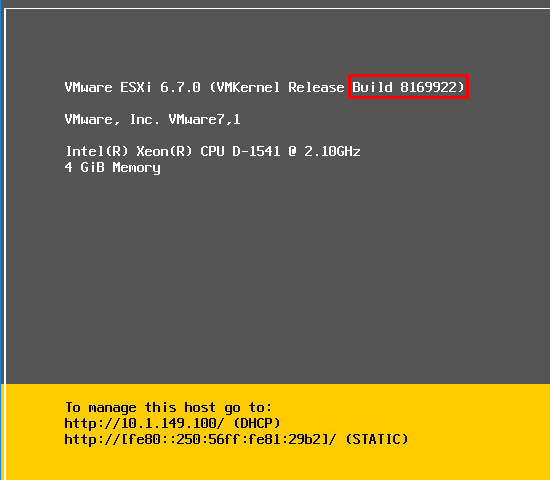
- #HOW TO SETUP ISCSI VMWARE ESXI 6.7 HOW TO#
- #HOW TO SETUP ISCSI VMWARE ESXI 6.7 SOFTWARE#
- #HOW TO SETUP ISCSI VMWARE ESXI 6.7 PASSWORD#
Don’t enter the static IPs manually-they will autopopulate later once you fill in the Dynamic IP below and save the configuration.Ĩ. For Network Port Bindings, click on Add port bindings and select the default vmk0.ħ. Set Mutual Authentication as “ Do not use CHAP” as it’s not something we use.Ħ. You can find the credentials Name and Secret values from the Block Storage Portal page (e.g., Name : SL01SU17123123-H123525).Ĥ. Click on CHAP Authentication to reveal a dropdown menu for entering the credentials. This will be set later through the console or command line.ģ. Skip the Name and Alias fields for now-you will not be able to enter a name here. Set the first setting: iSCSI enabled to enabled.Ģ.
#HOW TO SETUP ISCSI VMWARE ESXI 6.7 SOFTWARE#
You will see a Software iSCSI option-select that and then follow the steps below:ġ. Note: You can find the configuration values for this section from the Block Storage Portal page-this includes IQN, CHAP credentials, and the target IPs. Then, click the Adapters tab on the loading page. Log in to the ESXI web client, and go to the Storage tab on the left-hand side.
#HOW TO SETUP ISCSI VMWARE ESXI 6.7 PASSWORD#
You should have a tab that says Passwords-click it to find the username and password needed to login to the ESXi client. You can find the password by going to your customer portal, clicking the Device tab, selecting the Devices List, then finding and clicking on your device name. If the private IP does not load for you, you can also use the following format: To login to the ESXi client, you will need appropriate credentials, which you can get from the Infrastructure portal. Simply copy the private IP of your VMware ESXi server into the browser and hit Enter-this should allow you to get the ESXi web client login page. If this works, you are good to go, and you can now access the private endpoint of your VMware ESXi server. You can test the VPN connectivity after connecting by pinging 10.0.80.11 from your command line tool (command prompt on Windows, terminal/command line on Linux). You can find instructions on connecting to our VPN by following this guide. To have access to the private IP, you will need to connect to the IBM Cloud Infrastructure SSL VPN. The ESXi web client is accessed through the private IP. You will be accessing the ESXi web client through the private IP. On a new provision on VMWare ESXi, the public interface is disabled by default and is unreachable. Next, select your VMware ESXi server, which will load the device details page with all the information. This time, click on Devices and then Device List.

You can find the steps for authorizing a storage for a host by reading this guide.Īfter it is authorized, access the Infrastructure portal again in a new tab. Once you’ve selected you block storage and the storage details page loads, authorize the storage for your VMware ESXi host use. Make sure you’ve selected the block storage specifically ordered for VMware ESXi-the other block storages will not work for our use. They will be listed as “iSCSI storage,” which lets you know that they use the iSCSI protocol. Once you are inside the portal, click on Storage and then click on Block storage. Please note that if you access through the latter link, you will want to click on the three-bar hamburger and select Infrastructure to be redirected to the IBM Cloud Infrastructure portal. You’ll first need to log into the Infrastructure portal.
#HOW TO SETUP ISCSI VMWARE ESXI 6.7 HOW TO#
In this article, I’ll cover how to mount IBM Cloud Block Storages onto this popular hypervisor using the iSCSI protocol. Repeat these steps for any more ESXi hosts you have in your cluster and then we’ll create a new VMFS volume in the next step.It seems like pretty much everyone is using VMware ESXi virtualization nowadays. Now click on the Devices tab and you should see the thin provisioned disk we created when configuring the iSCSI target.

Once the server is added you will need to click Rescan Adapter for the software adapter to detect any devices on the target. The IP address of my Ubuntu server is 10.1.1.201 (see this guide on how to create a static IP address on Ubuntu 18.04). For testing purposes I’m using the management network which is 10.1.1.0. Note: The IP address of the server must be on the same network as a VMkernal port group. The software iSCSI adapter should now be in the list of storage adapters.Įnter the IP address of the Ubuntu iSCSI server and then click OK.

Select Add software iSCSI adapter then click OK.


 0 kommentar(er)
0 kommentar(er)
